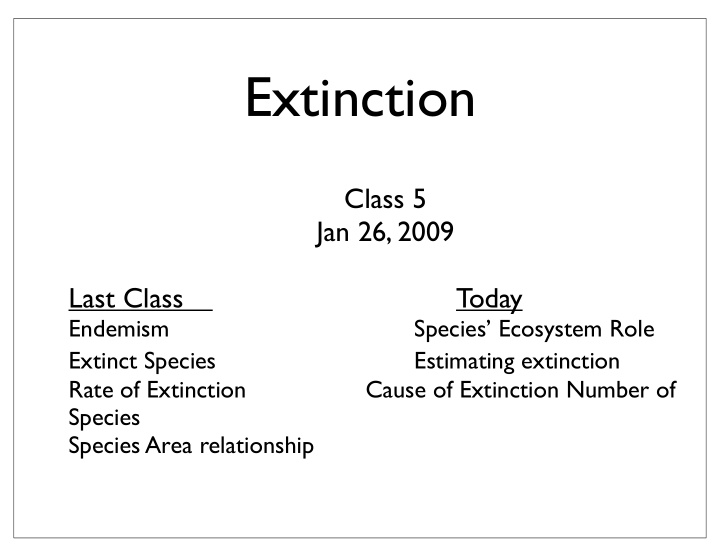



Extinction Class 5 Jan 26, 2009 Last Class � � � � � � Today Endemism � � � � � Species’ Ecosystem Role Estimating extinction � Extinct Species � � � � Rate of Extinction �� � Cause of Extinction Number of Species Species Area relationship
Geologic Extinctions Cretaceous Triassic explosion Triassic Permian Devonian Paleozoic Ordovician Cambrian explosion
Ecosystem Roles Dominant Species – Very common and have a strong effect on other members of the community.
Ecosystem Roles Dominant Species – Very common and have a strong effect on other members of the community. Ecosystem Engineers – Modify habitat; presence or absence will change community
Ecosystem Roles Dominant Species – Very common and have a strong effect on other members of the community. Ecosystem Engineers – Modify habitat; presence or absence will change community Keystone Species – species that has a greater impact on community than would be expected by its overall biomass.
Ecosystem Roles Keystone Species – species that has a greater impact on community than would be expected by its overall biomass.
Case Study: Sea Otters & Sea Urchins
Case Study: Sea Otters & Sea Urchins
Causes of Extinction
Measuring Current Extinctions Direct observation are difficult Indirect observation: species - area relationship
Estimating extinction rates Log(Number of species S) Log(Area A)
Estimating how many species go extinct Log(Number of species S) Log(Area A) using z=.15 (this is arbitrary) deforestation = 1.8% per year (Anow / Aoriginal = 98.2/100) 10 million species (Soriginal) Snow = 9,973,000
Causes of extinction?
Causes of extinction Habitat destruction habitat loss (less area = fewer species)
Causes of extinction Habitat destruction habitat loss (less area = fewer species) habitat fragmentation
Causes of extinction Habitat destruction habitat loss (less area = fewer species) habitat fragmentation Edge effects
Causes of extinction Habitat destruction Habitat loss (less area = fewer species) Habitat fragmentation Edge effects Isolation
Exotic species Exotic species: species introduced to regions outside of their native range Invasive species: an exotic species with strongly increasing populations (and most often detrimental effect on the native species or habitats)
Exotic species
Invasive species Brown tree snake Kudzu Zebra mussel Introduced to Guam, Introduced to the South- Introduced through boats into predated and eradicated all East USA for their edible Great Lakes, clogging up water native endemic bird species leaves and pretty flowers. intakes, removing food more Overgrowing forests, effective out of water column than changing native habitats natives.
Pollution Point sources Non-Point sources
Pollution Air Global warming Acid rain Ozone depletion, smog, ....
Pollution Water
Heavy metal Water Body Species Women of All Other Individuals childbearing age, (# of meals)* young children (# of meals) Lake Iamonia Largemouth Bass One per month One per week Lake Jackson Black Crappie, One per month One per week Bluegill, Largemouth Bass Lake Miccosukee Bluegill Two per week Two per week Largemouth Bass One per month One per week Lake Munson Black Crappie, Redear One per month One per week Sunfish Moore Lake Largemouth Bass One per month One per week http://www.myfloridaeh.com/community/fishconsumptionadvisories/FWFGuide.htm
Pollution Water Toxins Nutrients eutrophic vs oligotrophic PRESS RELEASE, JULY 26, 2004 LOUISIANA UNIVERSITIES MARINE CONSORTIUM AVERAGE SIZE "DEAD ZONE" IN ANYTHING BUT AN AVERAGE YEAR The coast-wide extent of the Louisiana "dead zone" mapped this week is slightly larger than average at 15,040 km 2 (5,800 square miles). The long-term average since mapping began in 1985 is 13,000 km 2 (5,000 square miles). The river flow and the offshore conditions prior to the mapping cruise were anything but normal and were more reminiscent of the Great Mississippi River Flood of 1993. The river in 2004 peaked in discharge several times in January, February March and May, followed by a prolonged above average flow that persisted from June into July, as in 1993.
Exploitation Commercial Recreational
Incidental Exploitation Bycatch: albatross, whales, .... Predator control in parks Recreation Pets
Diseases (Atelopus zeteki) Chytrid, a fungus, is believed to be one of the sources for amphibian decline www.clemetzoo.com/conservation/project_golden_frog.asp
Causes of extinction Habitat destruction Exotic species Pollution Exploitation Diseases
Recommend
More recommend